Unit 12: Organisational Behaviour and Sainsbury's Analysis Report
VerifiedAdded on 2022/11/30
|17
|6143
|353
Report
AI Summary
This report provides an in-depth analysis of organisational behaviour, focusing on the case of Sainsbury. It begins by exploring the impact of organisational culture, power, and politics on employee behaviour, highlighting how these factors influence the work environment and employee performance. The report then delves into various motivation theories, such as McGregor's Theory X and Y, and process theories, including the Porter-Lawler model, to explain how motivation techniques contribute to achieving organisational goals. Furthermore, it examines the dynamics of effective and ineffective teams and discusses key concepts and philosophies of organisational behaviour. The report emphasizes the importance of understanding individual and group behaviour within the organisation to enhance productivity and achieve business objectives. It highlights how Sainsbury utilizes various strategies to manage its employees and foster a positive work environment that supports employee growth and satisfaction, ultimately driving customer satisfaction and business success.
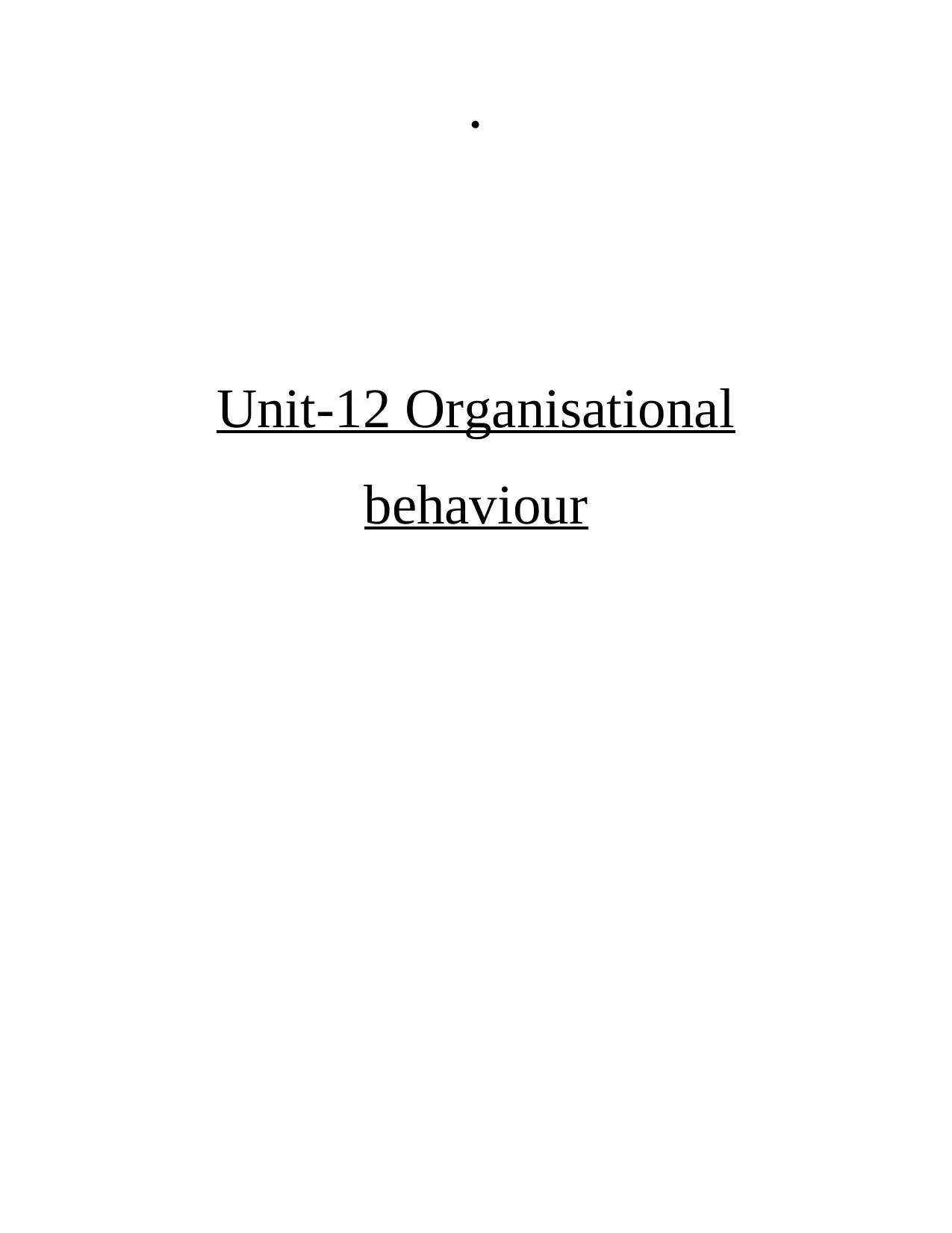
·
Unit-12 Organisational
behaviour
Unit-12 Organisational
behaviour
Paraphrase This Document
Need a fresh take? Get an instant paraphrase of this document with our AI Paraphraser
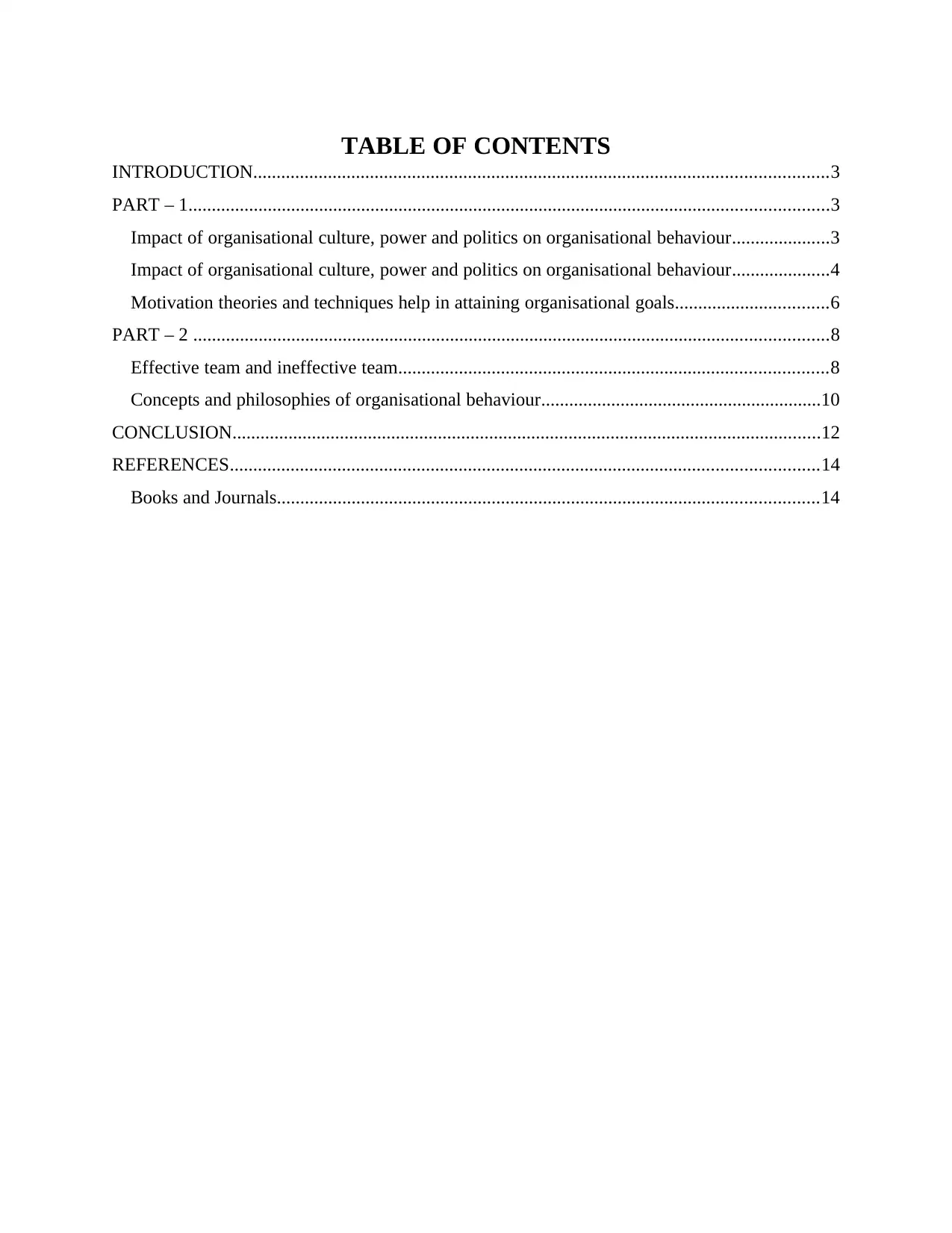
TABLE OF CONTENTS
INTRODUCTION...........................................................................................................................3
PART – 1.........................................................................................................................................3
Impact of organisational culture, power and politics on organisational behaviour.....................3
Impact of organisational culture, power and politics on organisational behaviour.....................4
Motivation theories and techniques help in attaining organisational goals.................................6
PART – 2 ........................................................................................................................................8
Effective team and ineffective team............................................................................................8
Concepts and philosophies of organisational behaviour............................................................10
CONCLUSION..............................................................................................................................12
REFERENCES..............................................................................................................................14
Books and Journals....................................................................................................................14
INTRODUCTION...........................................................................................................................3
PART – 1.........................................................................................................................................3
Impact of organisational culture, power and politics on organisational behaviour.....................3
Impact of organisational culture, power and politics on organisational behaviour.....................4
Motivation theories and techniques help in attaining organisational goals.................................6
PART – 2 ........................................................................................................................................8
Effective team and ineffective team............................................................................................8
Concepts and philosophies of organisational behaviour............................................................10
CONCLUSION..............................................................................................................................12
REFERENCES..............................................................................................................................14
Books and Journals....................................................................................................................14
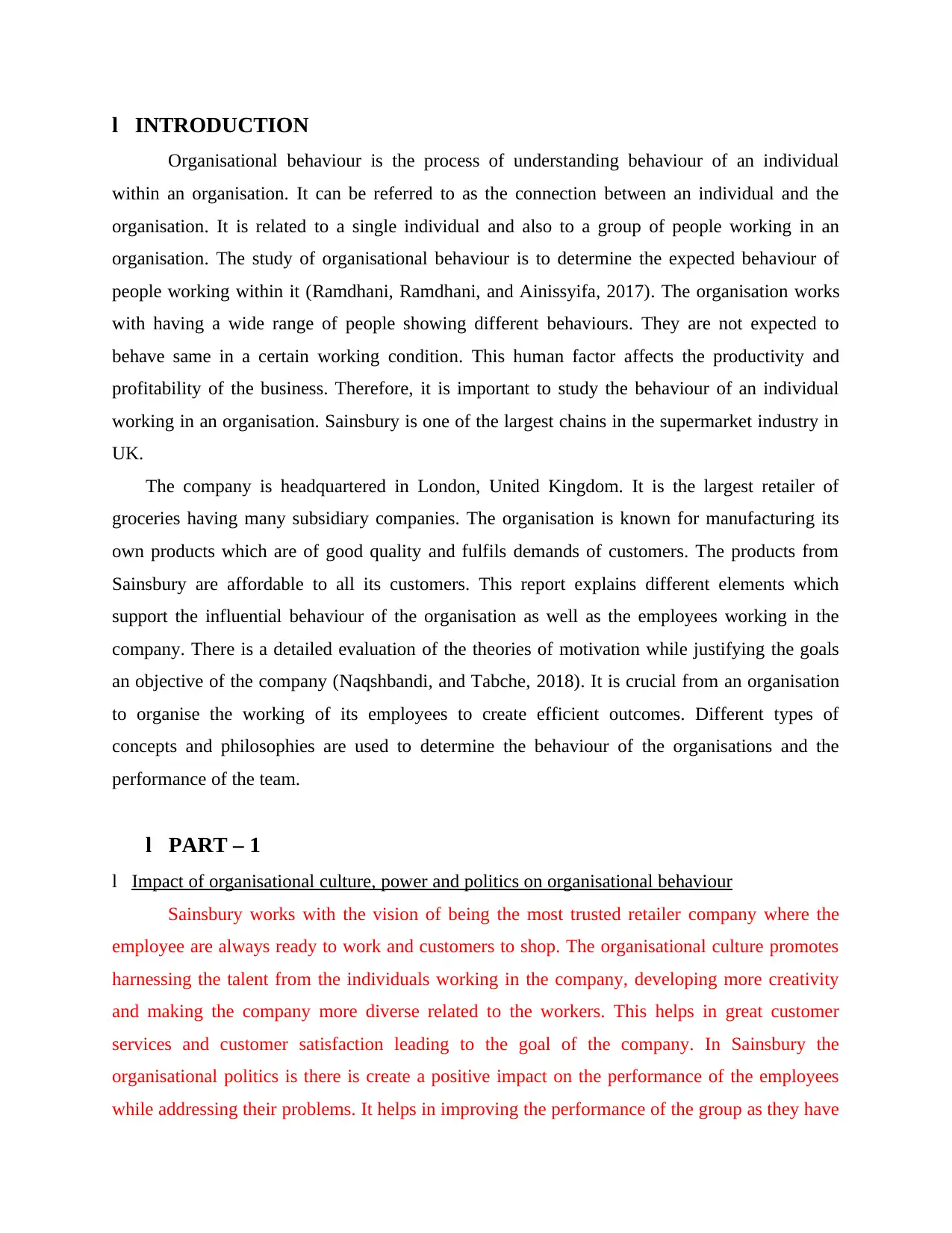
l壱INTRODUCTION
Organisational behaviour is the process of understanding behaviour of an individual
within an organisation. It can be referred to as the connection between an individual and the
organisation. It is related to a single individual and also to a group of people working in an
organisation. The study of organisational behaviour is to determine the expected behaviour of
people working within it (Ramdhani, Ramdhani, and Ainissyifa, 2017). The organisation works
with having a wide range of people showing different behaviours. They are not expected to
behave same in a certain working condition. This human factor affects the productivity and
profitability of the business. Therefore, it is important to study the behaviour of an individual
working in an organisation. Sainsbury is one of the largest chains in the supermarket industry in
UK.
The company is headquartered in London, United Kingdom. It is the largest retailer of
groceries having many subsidiary companies. The organisation is known for manufacturing its
own products which are of good quality and fulfils demands of customers. The products from
Sainsbury are affordable to all its customers. This report explains different elements which
support the influential behaviour of the organisation as well as the employees working in the
company. There is a detailed evaluation of the theories of motivation while justifying the goals
an objective of the company (Naqshbandi, and Tabche, 2018). It is crucial from an organisation
to organise the working of its employees to create efficient outcomes. Different types of
concepts and philosophies are used to determine the behaviour of the organisations and the
performance of the team.
l壱PART – 1
l弐Impact of organisational culture, power and politics on organisational behaviour
Sainsbury works with the vision of being the most trusted retailer company where the
employee are always ready to work and customers to shop. The organisational culture promotes
harnessing the talent from the individuals working in the company, developing more creativity
and making the company more diverse related to the workers. This helps in great customer
services and customer satisfaction leading to the goal of the company. In Sainsbury the
organisational politics is there is create a positive impact on the performance of the employees
while addressing their problems. It helps in improving the performance of the group as they have
Organisational behaviour is the process of understanding behaviour of an individual
within an organisation. It can be referred to as the connection between an individual and the
organisation. It is related to a single individual and also to a group of people working in an
organisation. The study of organisational behaviour is to determine the expected behaviour of
people working within it (Ramdhani, Ramdhani, and Ainissyifa, 2017). The organisation works
with having a wide range of people showing different behaviours. They are not expected to
behave same in a certain working condition. This human factor affects the productivity and
profitability of the business. Therefore, it is important to study the behaviour of an individual
working in an organisation. Sainsbury is one of the largest chains in the supermarket industry in
UK.
The company is headquartered in London, United Kingdom. It is the largest retailer of
groceries having many subsidiary companies. The organisation is known for manufacturing its
own products which are of good quality and fulfils demands of customers. The products from
Sainsbury are affordable to all its customers. This report explains different elements which
support the influential behaviour of the organisation as well as the employees working in the
company. There is a detailed evaluation of the theories of motivation while justifying the goals
an objective of the company (Naqshbandi, and Tabche, 2018). It is crucial from an organisation
to organise the working of its employees to create efficient outcomes. Different types of
concepts and philosophies are used to determine the behaviour of the organisations and the
performance of the team.
l壱PART – 1
l弐Impact of organisational culture, power and politics on organisational behaviour
Sainsbury works with the vision of being the most trusted retailer company where the
employee are always ready to work and customers to shop. The organisational culture promotes
harnessing the talent from the individuals working in the company, developing more creativity
and making the company more diverse related to the workers. This helps in great customer
services and customer satisfaction leading to the goal of the company. In Sainsbury the
organisational politics is there is create a positive impact on the performance of the employees
while addressing their problems. It helps in improving the performance of the group as they have
⊘ This is a preview!⊘
Do you want full access?
Subscribe today to unlock all pages.

Trusted by 1+ million students worldwide
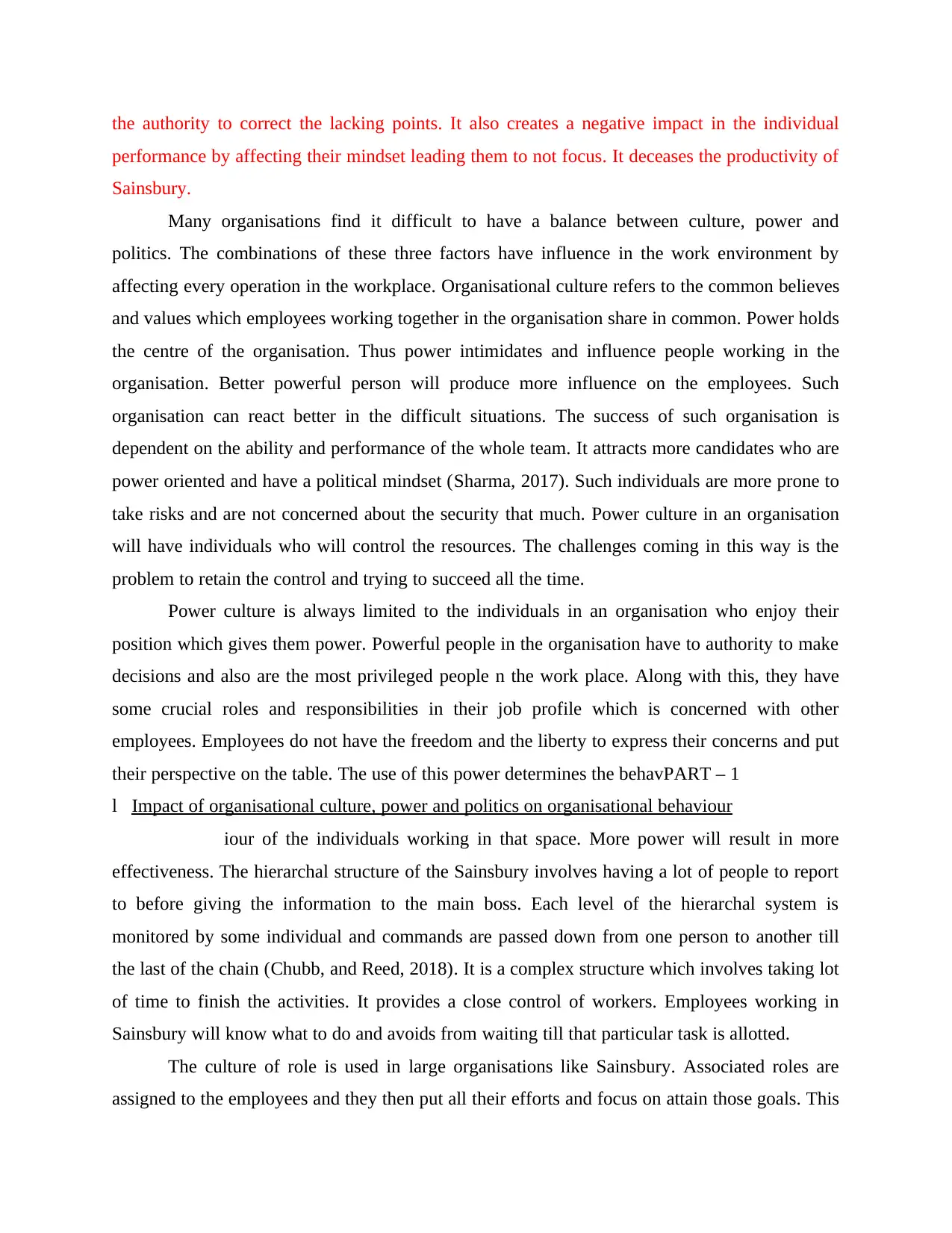
the authority to correct the lacking points. It also creates a negative impact in the individual
performance by affecting their mindset leading them to not focus. It deceases the productivity of
Sainsbury.
Many organisations find it difficult to have a balance between culture, power and
politics. The combinations of these three factors have influence in the work environment by
affecting every operation in the workplace. Organisational culture refers to the common believes
and values which employees working together in the organisation share in common. Power holds
the centre of the organisation. Thus power intimidates and influence people working in the
organisation. Better powerful person will produce more influence on the employees. Such
organisation can react better in the difficult situations. The success of such organisation is
dependent on the ability and performance of the whole team. It attracts more candidates who are
power oriented and have a political mindset (Sharma, 2017). Such individuals are more prone to
take risks and are not concerned about the security that much. Power culture in an organisation
will have individuals who will control the resources. The challenges coming in this way is the
problem to retain the control and trying to succeed all the time.
Power culture is always limited to the individuals in an organisation who enjoy their
position which gives them power. Powerful people in the organisation have to authority to make
decisions and also are the most privileged people n the work place. Along with this, they have
some crucial roles and responsibilities in their job profile which is concerned with other
employees. Employees do not have the freedom and the liberty to express their concerns and put
their perspective on the table. The use of this power determines the behavPART – 1
l弐Impact of organisational culture, power and politics on organisational behaviour
iour of the individuals working in that space. More power will result in more
effectiveness. The hierarchal structure of the Sainsbury involves having a lot of people to report
to before giving the information to the main boss. Each level of the hierarchal system is
monitored by some individual and commands are passed down from one person to another till
the last of the chain (Chubb, and Reed, 2018). It is a complex structure which involves taking lot
of time to finish the activities. It provides a close control of workers. Employees working in
Sainsbury will know what to do and avoids from waiting till that particular task is allotted.
The culture of role is used in large organisations like Sainsbury. Associated roles are
assigned to the employees and they then put all their efforts and focus on attain those goals. This
performance by affecting their mindset leading them to not focus. It deceases the productivity of
Sainsbury.
Many organisations find it difficult to have a balance between culture, power and
politics. The combinations of these three factors have influence in the work environment by
affecting every operation in the workplace. Organisational culture refers to the common believes
and values which employees working together in the organisation share in common. Power holds
the centre of the organisation. Thus power intimidates and influence people working in the
organisation. Better powerful person will produce more influence on the employees. Such
organisation can react better in the difficult situations. The success of such organisation is
dependent on the ability and performance of the whole team. It attracts more candidates who are
power oriented and have a political mindset (Sharma, 2017). Such individuals are more prone to
take risks and are not concerned about the security that much. Power culture in an organisation
will have individuals who will control the resources. The challenges coming in this way is the
problem to retain the control and trying to succeed all the time.
Power culture is always limited to the individuals in an organisation who enjoy their
position which gives them power. Powerful people in the organisation have to authority to make
decisions and also are the most privileged people n the work place. Along with this, they have
some crucial roles and responsibilities in their job profile which is concerned with other
employees. Employees do not have the freedom and the liberty to express their concerns and put
their perspective on the table. The use of this power determines the behavPART – 1
l弐Impact of organisational culture, power and politics on organisational behaviour
iour of the individuals working in that space. More power will result in more
effectiveness. The hierarchal structure of the Sainsbury involves having a lot of people to report
to before giving the information to the main boss. Each level of the hierarchal system is
monitored by some individual and commands are passed down from one person to another till
the last of the chain (Chubb, and Reed, 2018). It is a complex structure which involves taking lot
of time to finish the activities. It provides a close control of workers. Employees working in
Sainsbury will know what to do and avoids from waiting till that particular task is allotted.
The culture of role is used in large organisations like Sainsbury. Associated roles are
assigned to the employees and they then put all their efforts and focus on attain those goals. This
Paraphrase This Document
Need a fresh take? Get an instant paraphrase of this document with our AI Paraphraser
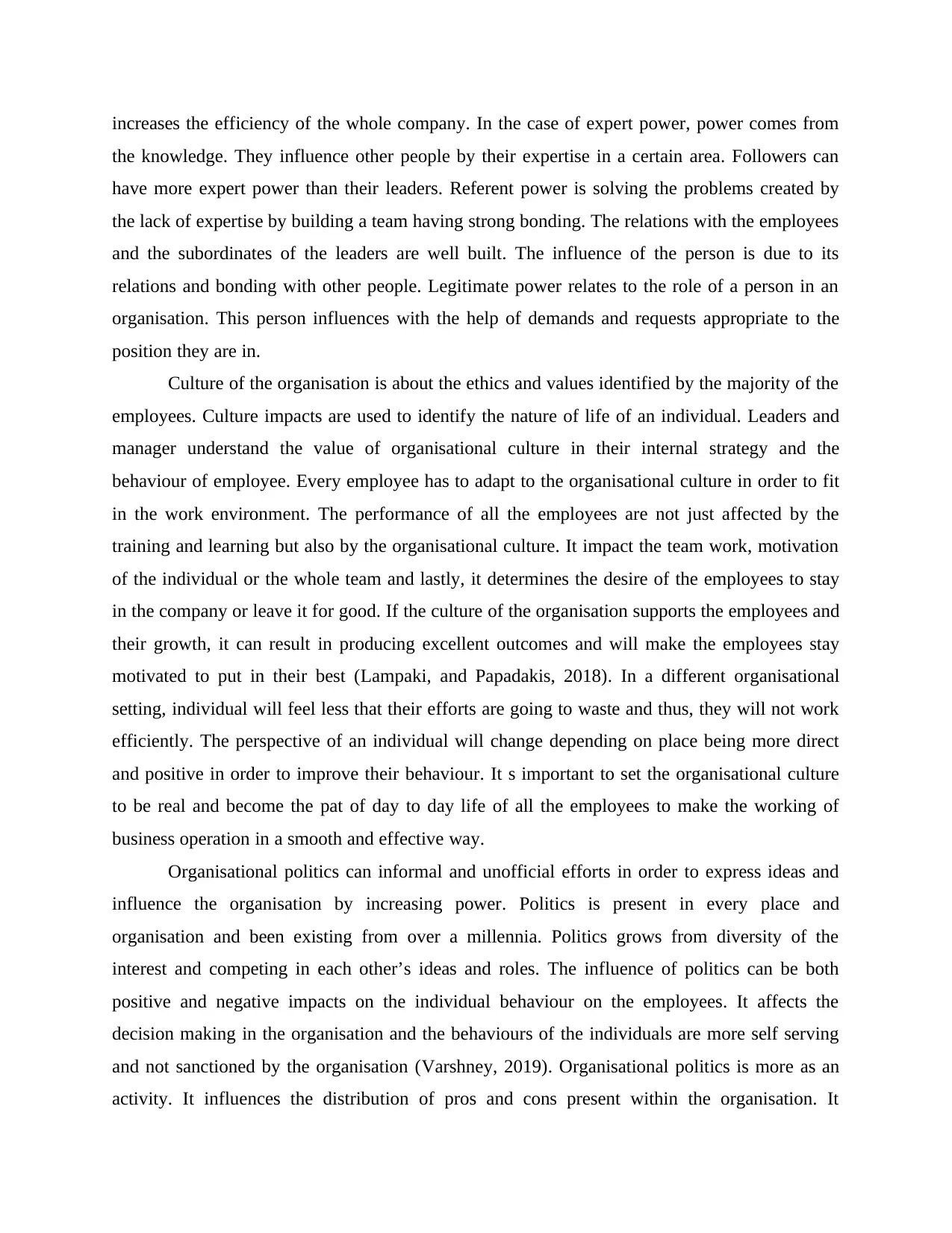
increases the efficiency of the whole company. In the case of expert power, power comes from
the knowledge. They influence other people by their expertise in a certain area. Followers can
have more expert power than their leaders. Referent power is solving the problems created by
the lack of expertise by building a team having strong bonding. The relations with the employees
and the subordinates of the leaders are well built. The influence of the person is due to its
relations and bonding with other people. Legitimate power relates to the role of a person in an
organisation. This person influences with the help of demands and requests appropriate to the
position they are in.
Culture of the organisation is about the ethics and values identified by the majority of the
employees. Culture impacts are used to identify the nature of life of an individual. Leaders and
manager understand the value of organisational culture in their internal strategy and the
behaviour of employee. Every employee has to adapt to the organisational culture in order to fit
in the work environment. The performance of all the employees are not just affected by the
training and learning but also by the organisational culture. It impact the team work, motivation
of the individual or the whole team and lastly, it determines the desire of the employees to stay
in the company or leave it for good. If the culture of the organisation supports the employees and
their growth, it can result in producing excellent outcomes and will make the employees stay
motivated to put in their best (Lampaki, and Papadakis, 2018). In a different organisational
setting, individual will feel less that their efforts are going to waste and thus, they will not work
efficiently. The perspective of an individual will change depending on place being more direct
and positive in order to improve their behaviour. It s important to set the organisational culture
to be real and become the pat of day to day life of all the employees to make the working of
business operation in a smooth and effective way.
Organisational politics can informal and unofficial efforts in order to express ideas and
influence the organisation by increasing power. Politics is present in every place and
organisation and been existing from over a millennia. Politics grows from diversity of the
interest and competing in each other’s ideas and roles. The influence of politics can be both
positive and negative impacts on the individual behaviour on the employees. It affects the
decision making in the organisation and the behaviours of the individuals are more self serving
and not sanctioned by the organisation (Varshney, 2019). Organisational politics is more as an
activity. It influences the distribution of pros and cons present within the organisation. It
the knowledge. They influence other people by their expertise in a certain area. Followers can
have more expert power than their leaders. Referent power is solving the problems created by
the lack of expertise by building a team having strong bonding. The relations with the employees
and the subordinates of the leaders are well built. The influence of the person is due to its
relations and bonding with other people. Legitimate power relates to the role of a person in an
organisation. This person influences with the help of demands and requests appropriate to the
position they are in.
Culture of the organisation is about the ethics and values identified by the majority of the
employees. Culture impacts are used to identify the nature of life of an individual. Leaders and
manager understand the value of organisational culture in their internal strategy and the
behaviour of employee. Every employee has to adapt to the organisational culture in order to fit
in the work environment. The performance of all the employees are not just affected by the
training and learning but also by the organisational culture. It impact the team work, motivation
of the individual or the whole team and lastly, it determines the desire of the employees to stay
in the company or leave it for good. If the culture of the organisation supports the employees and
their growth, it can result in producing excellent outcomes and will make the employees stay
motivated to put in their best (Lampaki, and Papadakis, 2018). In a different organisational
setting, individual will feel less that their efforts are going to waste and thus, they will not work
efficiently. The perspective of an individual will change depending on place being more direct
and positive in order to improve their behaviour. It s important to set the organisational culture
to be real and become the pat of day to day life of all the employees to make the working of
business operation in a smooth and effective way.
Organisational politics can informal and unofficial efforts in order to express ideas and
influence the organisation by increasing power. Politics is present in every place and
organisation and been existing from over a millennia. Politics grows from diversity of the
interest and competing in each other’s ideas and roles. The influence of politics can be both
positive and negative impacts on the individual behaviour on the employees. It affects the
decision making in the organisation and the behaviours of the individuals are more self serving
and not sanctioned by the organisation (Varshney, 2019). Organisational politics is more as an
activity. It influences the distribution of pros and cons present within the organisation. It
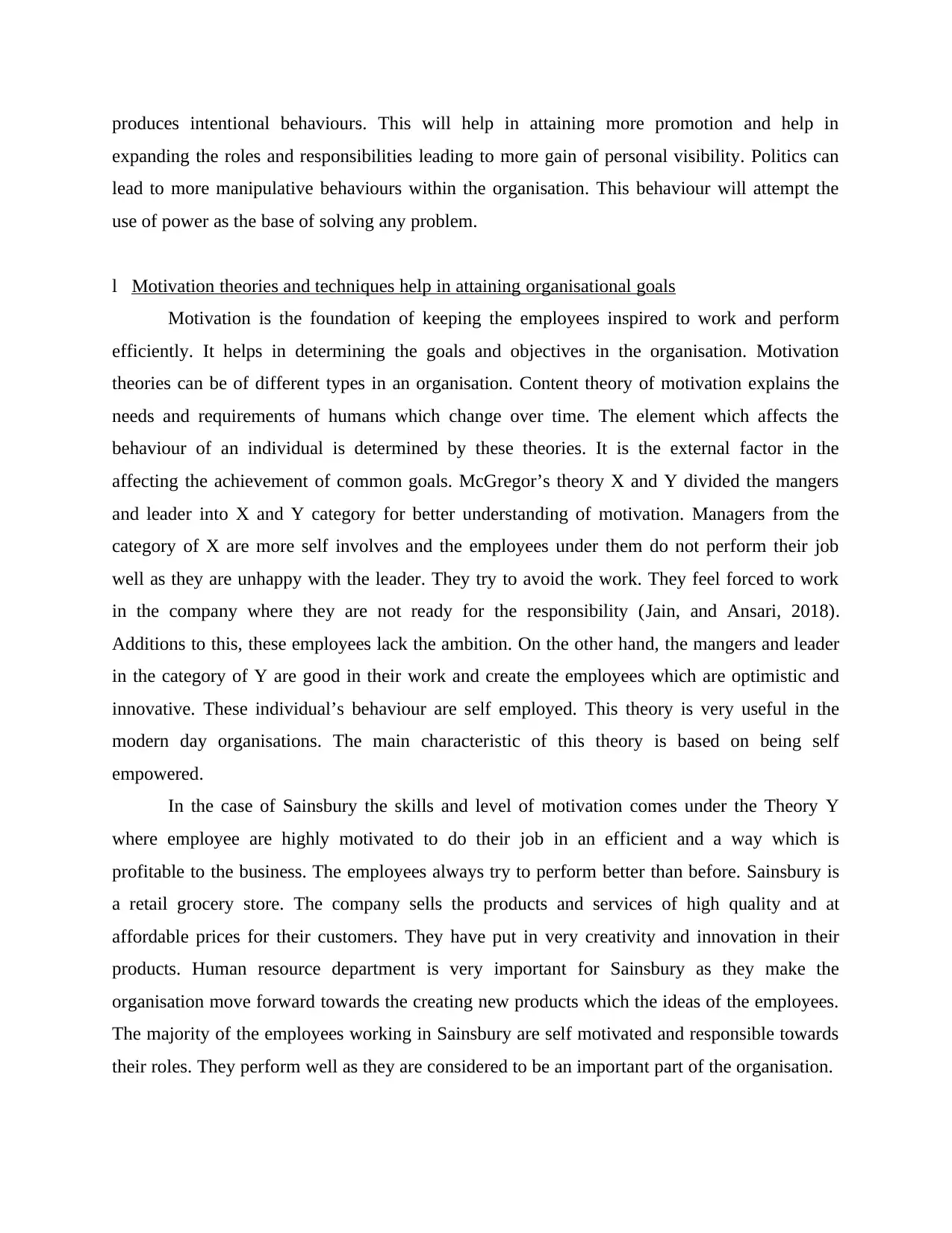
produces intentional behaviours. This will help in attaining more promotion and help in
expanding the roles and responsibilities leading to more gain of personal visibility. Politics can
lead to more manipulative behaviours within the organisation. This behaviour will attempt the
use of power as the base of solving any problem.
l弐Motivation theories and techniques help in attaining organisational goals
Motivation is the foundation of keeping the employees inspired to work and perform
efficiently. It helps in determining the goals and objectives in the organisation. Motivation
theories can be of different types in an organisation. Content theory of motivation explains the
needs and requirements of humans which change over time. The element which affects the
behaviour of an individual is determined by these theories. It is the external factor in the
affecting the achievement of common goals. McGregor’s theory X and Y divided the mangers
and leader into X and Y category for better understanding of motivation. Managers from the
category of X are more self involves and the employees under them do not perform their job
well as they are unhappy with the leader. They try to avoid the work. They feel forced to work
in the company where they are not ready for the responsibility (Jain, and Ansari, 2018).
Additions to this, these employees lack the ambition. On the other hand, the mangers and leader
in the category of Y are good in their work and create the employees which are optimistic and
innovative. These individual’s behaviour are self employed. This theory is very useful in the
modern day organisations. The main characteristic of this theory is based on being self
empowered.
In the case of Sainsbury the skills and level of motivation comes under the Theory Y
where employee are highly motivated to do their job in an efficient and a way which is
profitable to the business. The employees always try to perform better than before. Sainsbury is
a retail grocery store. The company sells the products and services of high quality and at
affordable prices for their customers. They have put in very creativity and innovation in their
products. Human resource department is very important for Sainsbury as they make the
organisation move forward towards the creating new products which the ideas of the employees.
The majority of the employees working in Sainsbury are self motivated and responsible towards
their roles. They perform well as they are considered to be an important part of the organisation.
expanding the roles and responsibilities leading to more gain of personal visibility. Politics can
lead to more manipulative behaviours within the organisation. This behaviour will attempt the
use of power as the base of solving any problem.
l弐Motivation theories and techniques help in attaining organisational goals
Motivation is the foundation of keeping the employees inspired to work and perform
efficiently. It helps in determining the goals and objectives in the organisation. Motivation
theories can be of different types in an organisation. Content theory of motivation explains the
needs and requirements of humans which change over time. The element which affects the
behaviour of an individual is determined by these theories. It is the external factor in the
affecting the achievement of common goals. McGregor’s theory X and Y divided the mangers
and leader into X and Y category for better understanding of motivation. Managers from the
category of X are more self involves and the employees under them do not perform their job
well as they are unhappy with the leader. They try to avoid the work. They feel forced to work
in the company where they are not ready for the responsibility (Jain, and Ansari, 2018).
Additions to this, these employees lack the ambition. On the other hand, the mangers and leader
in the category of Y are good in their work and create the employees which are optimistic and
innovative. These individual’s behaviour are self employed. This theory is very useful in the
modern day organisations. The main characteristic of this theory is based on being self
empowered.
In the case of Sainsbury the skills and level of motivation comes under the Theory Y
where employee are highly motivated to do their job in an efficient and a way which is
profitable to the business. The employees always try to perform better than before. Sainsbury is
a retail grocery store. The company sells the products and services of high quality and at
affordable prices for their customers. They have put in very creativity and innovation in their
products. Human resource department is very important for Sainsbury as they make the
organisation move forward towards the creating new products which the ideas of the employees.
The majority of the employees working in Sainsbury are self motivated and responsible towards
their roles. They perform well as they are considered to be an important part of the organisation.
⊘ This is a preview!⊘
Do you want full access?
Subscribe today to unlock all pages.

Trusted by 1+ million students worldwide
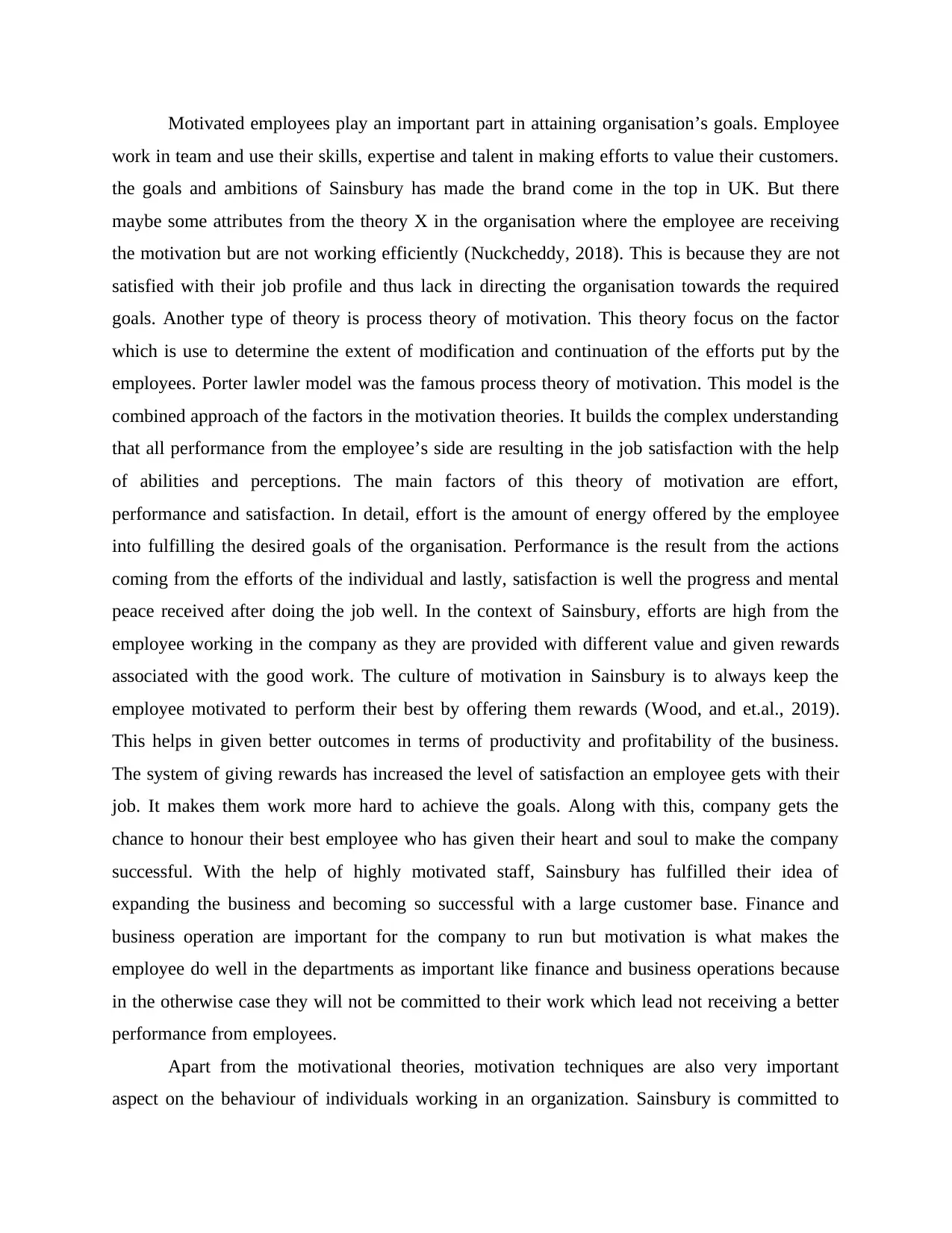
Motivated employees play an important part in attaining organisation’s goals. Employee
work in team and use their skills, expertise and talent in making efforts to value their customers.
the goals and ambitions of Sainsbury has made the brand come in the top in UK. But there
maybe some attributes from the theory X in the organisation where the employee are receiving
the motivation but are not working efficiently (Nuckcheddy, 2018). This is because they are not
satisfied with their job profile and thus lack in directing the organisation towards the required
goals. Another type of theory is process theory of motivation. This theory focus on the factor
which is use to determine the extent of modification and continuation of the efforts put by the
employees. Porter lawler model was the famous process theory of motivation. This model is the
combined approach of the factors in the motivation theories. It builds the complex understanding
that all performance from the employee’s side are resulting in the job satisfaction with the help
of abilities and perceptions. The main factors of this theory of motivation are effort,
performance and satisfaction. In detail, effort is the amount of energy offered by the employee
into fulfilling the desired goals of the organisation. Performance is the result from the actions
coming from the efforts of the individual and lastly, satisfaction is well the progress and mental
peace received after doing the job well. In the context of Sainsbury, efforts are high from the
employee working in the company as they are provided with different value and given rewards
associated with the good work. The culture of motivation in Sainsbury is to always keep the
employee motivated to perform their best by offering them rewards (Wood, and et.al., 2019).
This helps in given better outcomes in terms of productivity and profitability of the business.
The system of giving rewards has increased the level of satisfaction an employee gets with their
job. It makes them work more hard to achieve the goals. Along with this, company gets the
chance to honour their best employee who has given their heart and soul to make the company
successful. With the help of highly motivated staff, Sainsbury has fulfilled their idea of
expanding the business and becoming so successful with a large customer base. Finance and
business operation are important for the company to run but motivation is what makes the
employee do well in the departments as important like finance and business operations because
in the otherwise case they will not be committed to their work which lead not receiving a better
performance from employees.
Apart from the motivational theories, motivation techniques are also very important
aspect on the behaviour of individuals working in an organization. Sainsbury is committed to
work in team and use their skills, expertise and talent in making efforts to value their customers.
the goals and ambitions of Sainsbury has made the brand come in the top in UK. But there
maybe some attributes from the theory X in the organisation where the employee are receiving
the motivation but are not working efficiently (Nuckcheddy, 2018). This is because they are not
satisfied with their job profile and thus lack in directing the organisation towards the required
goals. Another type of theory is process theory of motivation. This theory focus on the factor
which is use to determine the extent of modification and continuation of the efforts put by the
employees. Porter lawler model was the famous process theory of motivation. This model is the
combined approach of the factors in the motivation theories. It builds the complex understanding
that all performance from the employee’s side are resulting in the job satisfaction with the help
of abilities and perceptions. The main factors of this theory of motivation are effort,
performance and satisfaction. In detail, effort is the amount of energy offered by the employee
into fulfilling the desired goals of the organisation. Performance is the result from the actions
coming from the efforts of the individual and lastly, satisfaction is well the progress and mental
peace received after doing the job well. In the context of Sainsbury, efforts are high from the
employee working in the company as they are provided with different value and given rewards
associated with the good work. The culture of motivation in Sainsbury is to always keep the
employee motivated to perform their best by offering them rewards (Wood, and et.al., 2019).
This helps in given better outcomes in terms of productivity and profitability of the business.
The system of giving rewards has increased the level of satisfaction an employee gets with their
job. It makes them work more hard to achieve the goals. Along with this, company gets the
chance to honour their best employee who has given their heart and soul to make the company
successful. With the help of highly motivated staff, Sainsbury has fulfilled their idea of
expanding the business and becoming so successful with a large customer base. Finance and
business operation are important for the company to run but motivation is what makes the
employee do well in the departments as important like finance and business operations because
in the otherwise case they will not be committed to their work which lead not receiving a better
performance from employees.
Apart from the motivational theories, motivation techniques are also very important
aspect on the behaviour of individuals working in an organization. Sainsbury is committed to
Paraphrase This Document
Need a fresh take? Get an instant paraphrase of this document with our AI Paraphraser
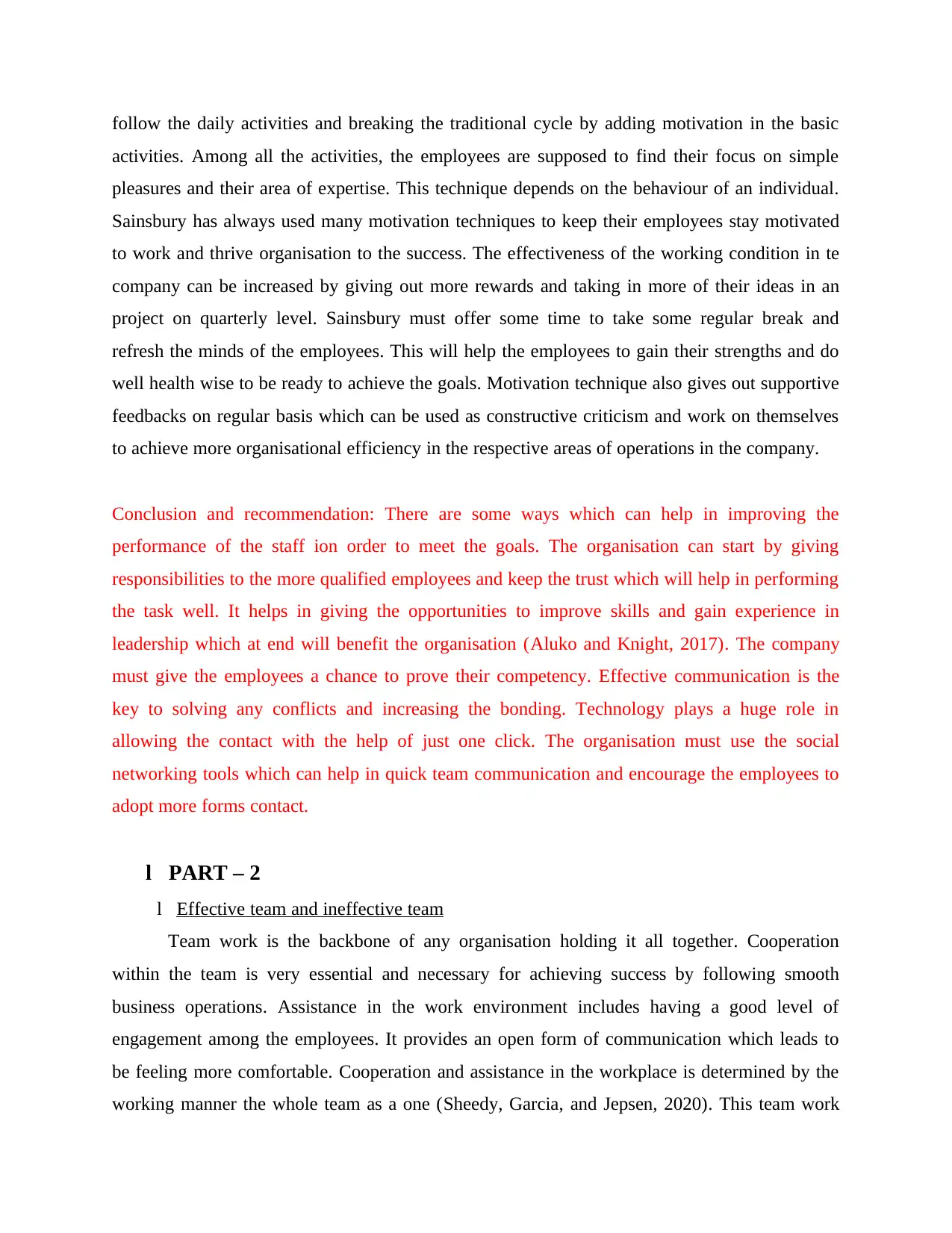
follow the daily activities and breaking the traditional cycle by adding motivation in the basic
activities. Among all the activities, the employees are supposed to find their focus on simple
pleasures and their area of expertise. This technique depends on the behaviour of an individual.
Sainsbury has always used many motivation techniques to keep their employees stay motivated
to work and thrive organisation to the success. The effectiveness of the working condition in te
company can be increased by giving out more rewards and taking in more of their ideas in an
project on quarterly level. Sainsbury must offer some time to take some regular break and
refresh the minds of the employees. This will help the employees to gain their strengths and do
well health wise to be ready to achieve the goals. Motivation technique also gives out supportive
feedbacks on regular basis which can be used as constructive criticism and work on themselves
to achieve more organisational efficiency in the respective areas of operations in the company.
Conclusion and recommendation: There are some ways which can help in improving the
performance of the staff ion order to meet the goals. The organisation can start by giving
responsibilities to the more qualified employees and keep the trust which will help in performing
the task well. It helps in giving the opportunities to improve skills and gain experience in
leadership which at end will benefit the organisation (Aluko and Knight, 2017). The company
must give the employees a chance to prove their competency. Effective communication is the
key to solving any conflicts and increasing the bonding. Technology plays a huge role in
allowing the contact with the help of just one click. The organisation must use the social
networking tools which can help in quick team communication and encourage the employees to
adopt more forms contact.
l壱PART – 2
l弐Effective team and ineffective team
Team work is the backbone of any organisation holding it all together. Cooperation
within the team is very essential and necessary for achieving success by following smooth
business operations. Assistance in the work environment includes having a good level of
engagement among the employees. It provides an open form of communication which leads to
be feeling more comfortable. Cooperation and assistance in the workplace is determined by the
working manner the whole team as a one (Sheedy, Garcia, and Jepsen, 2020). This team work
activities. Among all the activities, the employees are supposed to find their focus on simple
pleasures and their area of expertise. This technique depends on the behaviour of an individual.
Sainsbury has always used many motivation techniques to keep their employees stay motivated
to work and thrive organisation to the success. The effectiveness of the working condition in te
company can be increased by giving out more rewards and taking in more of their ideas in an
project on quarterly level. Sainsbury must offer some time to take some regular break and
refresh the minds of the employees. This will help the employees to gain their strengths and do
well health wise to be ready to achieve the goals. Motivation technique also gives out supportive
feedbacks on regular basis which can be used as constructive criticism and work on themselves
to achieve more organisational efficiency in the respective areas of operations in the company.
Conclusion and recommendation: There are some ways which can help in improving the
performance of the staff ion order to meet the goals. The organisation can start by giving
responsibilities to the more qualified employees and keep the trust which will help in performing
the task well. It helps in giving the opportunities to improve skills and gain experience in
leadership which at end will benefit the organisation (Aluko and Knight, 2017). The company
must give the employees a chance to prove their competency. Effective communication is the
key to solving any conflicts and increasing the bonding. Technology plays a huge role in
allowing the contact with the help of just one click. The organisation must use the social
networking tools which can help in quick team communication and encourage the employees to
adopt more forms contact.
l壱PART – 2
l弐Effective team and ineffective team
Team work is the backbone of any organisation holding it all together. Cooperation
within the team is very essential and necessary for achieving success by following smooth
business operations. Assistance in the work environment includes having a good level of
engagement among the employees. It provides an open form of communication which leads to
be feeling more comfortable. Cooperation and assistance in the workplace is determined by the
working manner the whole team as a one (Sheedy, Garcia, and Jepsen, 2020). This team work
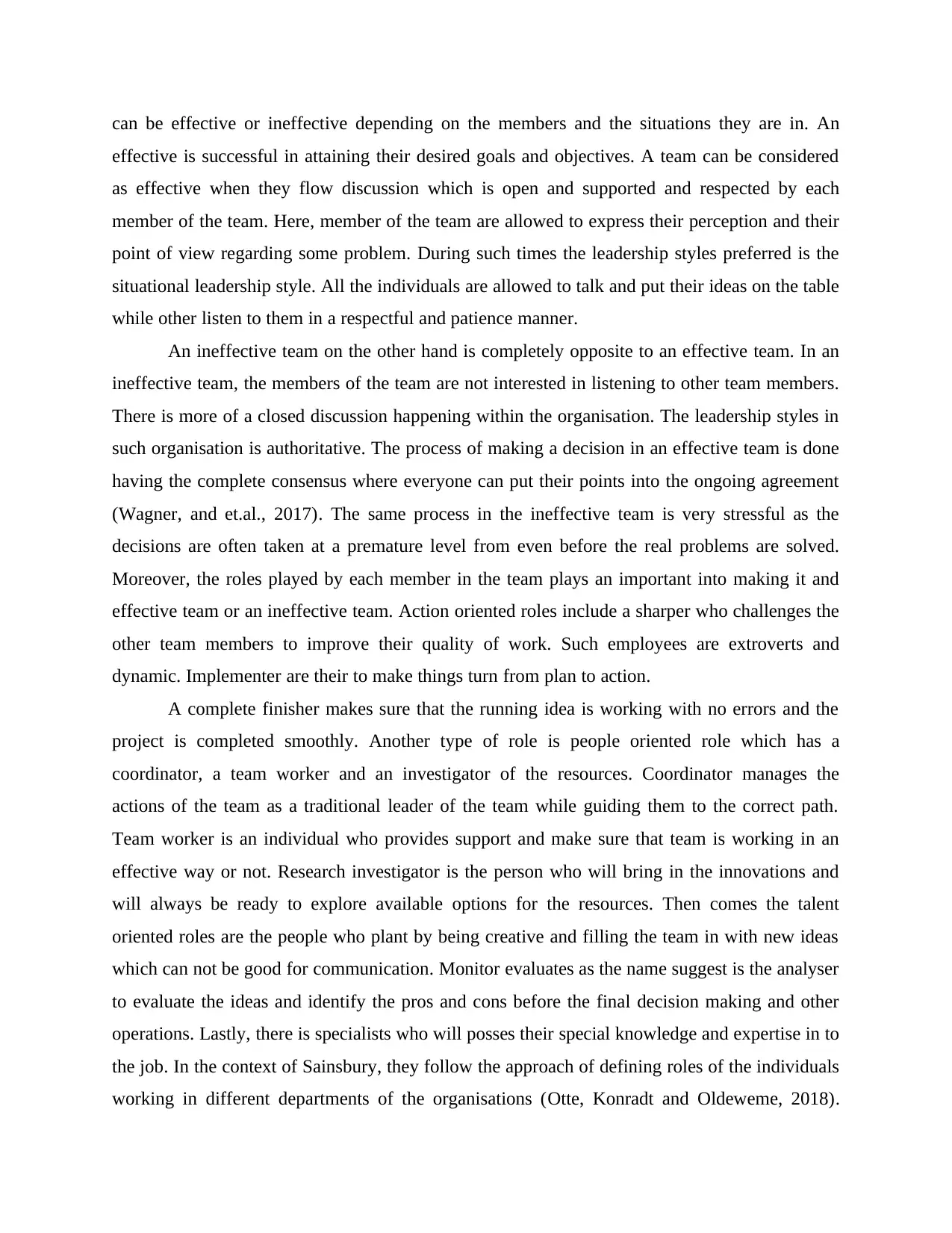
can be effective or ineffective depending on the members and the situations they are in. An
effective is successful in attaining their desired goals and objectives. A team can be considered
as effective when they flow discussion which is open and supported and respected by each
member of the team. Here, member of the team are allowed to express their perception and their
point of view regarding some problem. During such times the leadership styles preferred is the
situational leadership style. All the individuals are allowed to talk and put their ideas on the table
while other listen to them in a respectful and patience manner.
An ineffective team on the other hand is completely opposite to an effective team. In an
ineffective team, the members of the team are not interested in listening to other team members.
There is more of a closed discussion happening within the organisation. The leadership styles in
such organisation is authoritative. The process of making a decision in an effective team is done
having the complete consensus where everyone can put their points into the ongoing agreement
(Wagner, and et.al., 2017). The same process in the ineffective team is very stressful as the
decisions are often taken at a premature level from even before the real problems are solved.
Moreover, the roles played by each member in the team plays an important into making it and
effective team or an ineffective team. Action oriented roles include a sharper who challenges the
other team members to improve their quality of work. Such employees are extroverts and
dynamic. Implementer are their to make things turn from plan to action.
A complete finisher makes sure that the running idea is working with no errors and the
project is completed smoothly. Another type of role is people oriented role which has a
coordinator, a team worker and an investigator of the resources. Coordinator manages the
actions of the team as a traditional leader of the team while guiding them to the correct path.
Team worker is an individual who provides support and make sure that team is working in an
effective way or not. Research investigator is the person who will bring in the innovations and
will always be ready to explore available options for the resources. Then comes the talent
oriented roles are the people who plant by being creative and filling the team in with new ideas
which can not be good for communication. Monitor evaluates as the name suggest is the analyser
to evaluate the ideas and identify the pros and cons before the final decision making and other
operations. Lastly, there is specialists who will posses their special knowledge and expertise in to
the job. In the context of Sainsbury, they follow the approach of defining roles of the individuals
working in different departments of the organisations (Otte, Konradt and Oldeweme, 2018).
effective is successful in attaining their desired goals and objectives. A team can be considered
as effective when they flow discussion which is open and supported and respected by each
member of the team. Here, member of the team are allowed to express their perception and their
point of view regarding some problem. During such times the leadership styles preferred is the
situational leadership style. All the individuals are allowed to talk and put their ideas on the table
while other listen to them in a respectful and patience manner.
An ineffective team on the other hand is completely opposite to an effective team. In an
ineffective team, the members of the team are not interested in listening to other team members.
There is more of a closed discussion happening within the organisation. The leadership styles in
such organisation is authoritative. The process of making a decision in an effective team is done
having the complete consensus where everyone can put their points into the ongoing agreement
(Wagner, and et.al., 2017). The same process in the ineffective team is very stressful as the
decisions are often taken at a premature level from even before the real problems are solved.
Moreover, the roles played by each member in the team plays an important into making it and
effective team or an ineffective team. Action oriented roles include a sharper who challenges the
other team members to improve their quality of work. Such employees are extroverts and
dynamic. Implementer are their to make things turn from plan to action.
A complete finisher makes sure that the running idea is working with no errors and the
project is completed smoothly. Another type of role is people oriented role which has a
coordinator, a team worker and an investigator of the resources. Coordinator manages the
actions of the team as a traditional leader of the team while guiding them to the correct path.
Team worker is an individual who provides support and make sure that team is working in an
effective way or not. Research investigator is the person who will bring in the innovations and
will always be ready to explore available options for the resources. Then comes the talent
oriented roles are the people who plant by being creative and filling the team in with new ideas
which can not be good for communication. Monitor evaluates as the name suggest is the analyser
to evaluate the ideas and identify the pros and cons before the final decision making and other
operations. Lastly, there is specialists who will posses their special knowledge and expertise in to
the job. In the context of Sainsbury, they follow the approach of defining roles of the individuals
working in different departments of the organisations (Otte, Konradt and Oldeweme, 2018).
⊘ This is a preview!⊘
Do you want full access?
Subscribe today to unlock all pages.

Trusted by 1+ million students worldwide
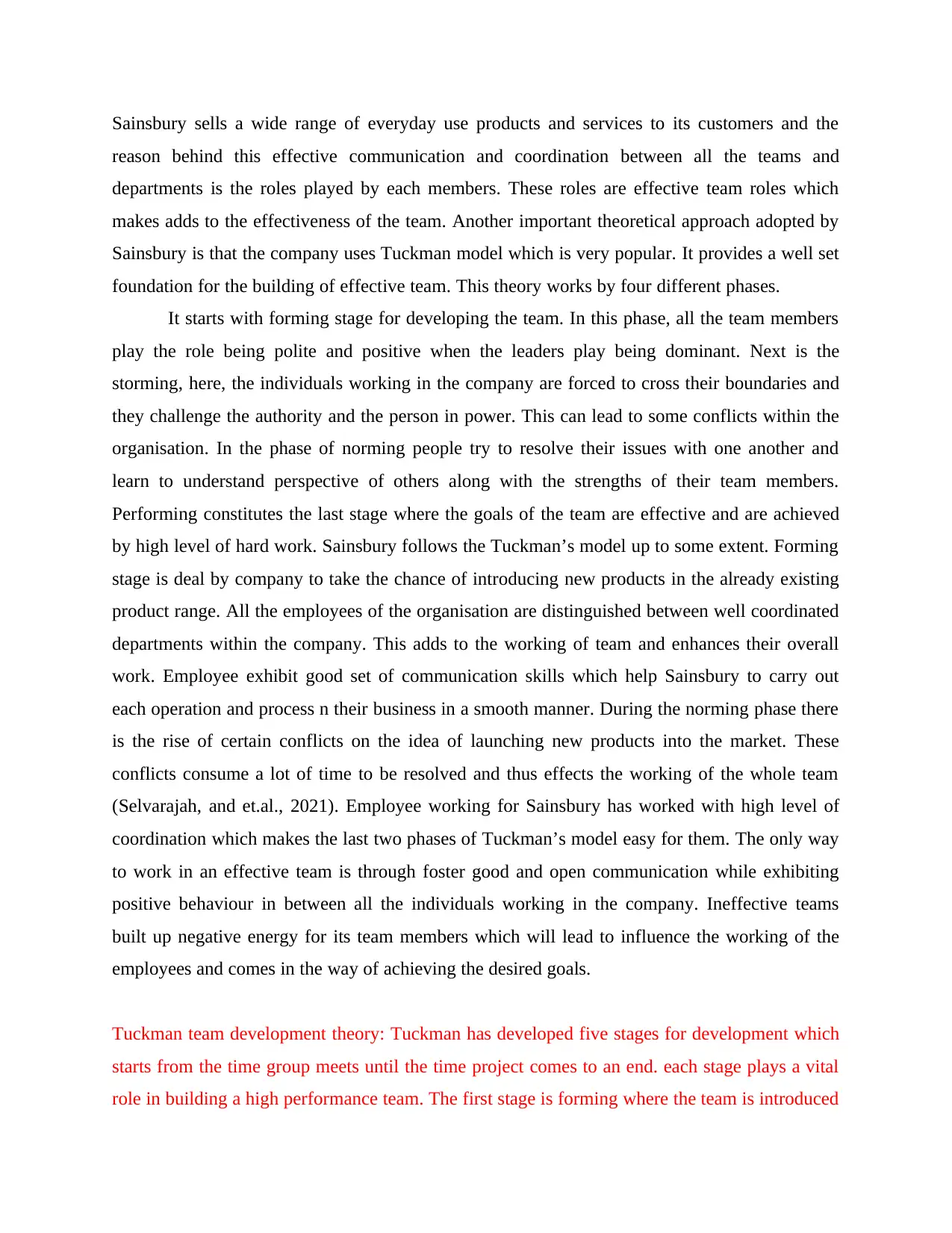
Sainsbury sells a wide range of everyday use products and services to its customers and the
reason behind this effective communication and coordination between all the teams and
departments is the roles played by each members. These roles are effective team roles which
makes adds to the effectiveness of the team. Another important theoretical approach adopted by
Sainsbury is that the company uses Tuckman model which is very popular. It provides a well set
foundation for the building of effective team. This theory works by four different phases.
It starts with forming stage for developing the team. In this phase, all the team members
play the role being polite and positive when the leaders play being dominant. Next is the
storming, here, the individuals working in the company are forced to cross their boundaries and
they challenge the authority and the person in power. This can lead to some conflicts within the
organisation. In the phase of norming people try to resolve their issues with one another and
learn to understand perspective of others along with the strengths of their team members.
Performing constitutes the last stage where the goals of the team are effective and are achieved
by high level of hard work. Sainsbury follows the Tuckman’s model up to some extent. Forming
stage is deal by company to take the chance of introducing new products in the already existing
product range. All the employees of the organisation are distinguished between well coordinated
departments within the company. This adds to the working of team and enhances their overall
work. Employee exhibit good set of communication skills which help Sainsbury to carry out
each operation and process n their business in a smooth manner. During the norming phase there
is the rise of certain conflicts on the idea of launching new products into the market. These
conflicts consume a lot of time to be resolved and thus effects the working of the whole team
(Selvarajah, and et.al., 2021). Employee working for Sainsbury has worked with high level of
coordination which makes the last two phases of Tuckman’s model easy for them. The only way
to work in an effective team is through foster good and open communication while exhibiting
positive behaviour in between all the individuals working in the company. Ineffective teams
built up negative energy for its team members which will lead to influence the working of the
employees and comes in the way of achieving the desired goals.
Tuckman team development theory: Tuckman has developed five stages for development which
starts from the time group meets until the time project comes to an end. each stage plays a vital
role in building a high performance team. The first stage is forming where the team is introduced
reason behind this effective communication and coordination between all the teams and
departments is the roles played by each members. These roles are effective team roles which
makes adds to the effectiveness of the team. Another important theoretical approach adopted by
Sainsbury is that the company uses Tuckman model which is very popular. It provides a well set
foundation for the building of effective team. This theory works by four different phases.
It starts with forming stage for developing the team. In this phase, all the team members
play the role being polite and positive when the leaders play being dominant. Next is the
storming, here, the individuals working in the company are forced to cross their boundaries and
they challenge the authority and the person in power. This can lead to some conflicts within the
organisation. In the phase of norming people try to resolve their issues with one another and
learn to understand perspective of others along with the strengths of their team members.
Performing constitutes the last stage where the goals of the team are effective and are achieved
by high level of hard work. Sainsbury follows the Tuckman’s model up to some extent. Forming
stage is deal by company to take the chance of introducing new products in the already existing
product range. All the employees of the organisation are distinguished between well coordinated
departments within the company. This adds to the working of team and enhances their overall
work. Employee exhibit good set of communication skills which help Sainsbury to carry out
each operation and process n their business in a smooth manner. During the norming phase there
is the rise of certain conflicts on the idea of launching new products into the market. These
conflicts consume a lot of time to be resolved and thus effects the working of the whole team
(Selvarajah, and et.al., 2021). Employee working for Sainsbury has worked with high level of
coordination which makes the last two phases of Tuckman’s model easy for them. The only way
to work in an effective team is through foster good and open communication while exhibiting
positive behaviour in between all the individuals working in the company. Ineffective teams
built up negative energy for its team members which will lead to influence the working of the
employees and comes in the way of achieving the desired goals.
Tuckman team development theory: Tuckman has developed five stages for development which
starts from the time group meets until the time project comes to an end. each stage plays a vital
role in building a high performance team. The first stage is forming where the team is introduced
Paraphrase This Document
Need a fresh take? Get an instant paraphrase of this document with our AI Paraphraser
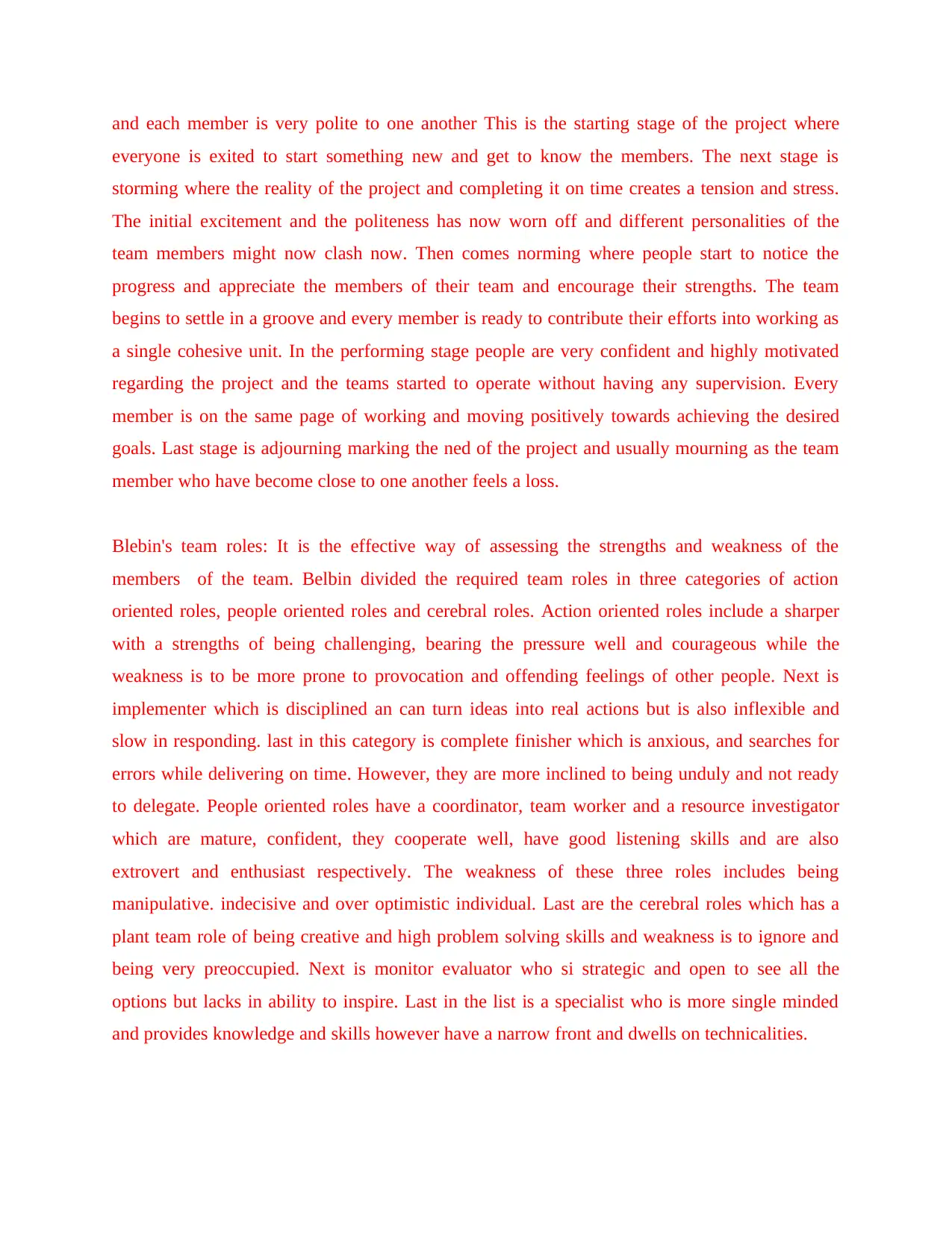
and each member is very polite to one another This is the starting stage of the project where
everyone is exited to start something new and get to know the members. The next stage is
storming where the reality of the project and completing it on time creates a tension and stress.
The initial excitement and the politeness has now worn off and different personalities of the
team members might now clash now. Then comes norming where people start to notice the
progress and appreciate the members of their team and encourage their strengths. The team
begins to settle in a groove and every member is ready to contribute their efforts into working as
a single cohesive unit. In the performing stage people are very confident and highly motivated
regarding the project and the teams started to operate without having any supervision. Every
member is on the same page of working and moving positively towards achieving the desired
goals. Last stage is adjourning marking the ned of the project and usually mourning as the team
member who have become close to one another feels a loss.
Blebin's team roles: It is the effective way of assessing the strengths and weakness of the
members of the team. Belbin divided the required team roles in three categories of action
oriented roles, people oriented roles and cerebral roles. Action oriented roles include a sharper
with a strengths of being challenging, bearing the pressure well and courageous while the
weakness is to be more prone to provocation and offending feelings of other people. Next is
implementer which is disciplined an can turn ideas into real actions but is also inflexible and
slow in responding. last in this category is complete finisher which is anxious, and searches for
errors while delivering on time. However, they are more inclined to being unduly and not ready
to delegate. People oriented roles have a coordinator, team worker and a resource investigator
which are mature, confident, they cooperate well, have good listening skills and are also
extrovert and enthusiast respectively. The weakness of these three roles includes being
manipulative. indecisive and over optimistic individual. Last are the cerebral roles which has a
plant team role of being creative and high problem solving skills and weakness is to ignore and
being very preoccupied. Next is monitor evaluator who si strategic and open to see all the
options but lacks in ability to inspire. Last in the list is a specialist who is more single minded
and provides knowledge and skills however have a narrow front and dwells on technicalities.
everyone is exited to start something new and get to know the members. The next stage is
storming where the reality of the project and completing it on time creates a tension and stress.
The initial excitement and the politeness has now worn off and different personalities of the
team members might now clash now. Then comes norming where people start to notice the
progress and appreciate the members of their team and encourage their strengths. The team
begins to settle in a groove and every member is ready to contribute their efforts into working as
a single cohesive unit. In the performing stage people are very confident and highly motivated
regarding the project and the teams started to operate without having any supervision. Every
member is on the same page of working and moving positively towards achieving the desired
goals. Last stage is adjourning marking the ned of the project and usually mourning as the team
member who have become close to one another feels a loss.
Blebin's team roles: It is the effective way of assessing the strengths and weakness of the
members of the team. Belbin divided the required team roles in three categories of action
oriented roles, people oriented roles and cerebral roles. Action oriented roles include a sharper
with a strengths of being challenging, bearing the pressure well and courageous while the
weakness is to be more prone to provocation and offending feelings of other people. Next is
implementer which is disciplined an can turn ideas into real actions but is also inflexible and
slow in responding. last in this category is complete finisher which is anxious, and searches for
errors while delivering on time. However, they are more inclined to being unduly and not ready
to delegate. People oriented roles have a coordinator, team worker and a resource investigator
which are mature, confident, they cooperate well, have good listening skills and are also
extrovert and enthusiast respectively. The weakness of these three roles includes being
manipulative. indecisive and over optimistic individual. Last are the cerebral roles which has a
plant team role of being creative and high problem solving skills and weakness is to ignore and
being very preoccupied. Next is monitor evaluator who si strategic and open to see all the
options but lacks in ability to inspire. Last in the list is a specialist who is more single minded
and provides knowledge and skills however have a narrow front and dwells on technicalities.
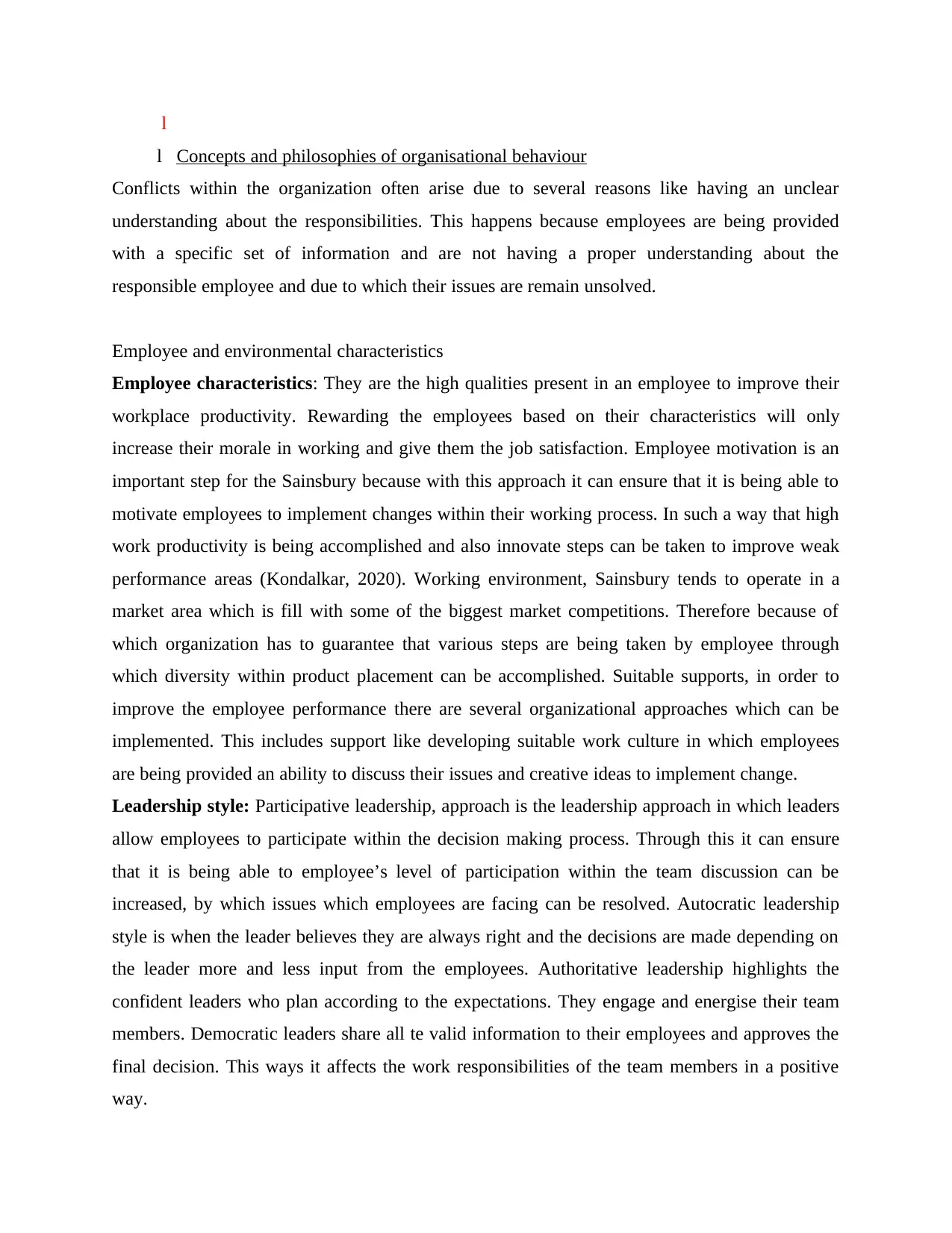
l弐
l弐Concepts and philosophies of organisational behaviour
Conflicts within the organization often arise due to several reasons like having an unclear
understanding about the responsibilities. This happens because employees are being provided
with a specific set of information and are not having a proper understanding about the
responsible employee and due to which their issues are remain unsolved.
Employee and environmental characteristics
Employee characteristics: They are the high qualities present in an employee to improve their
workplace productivity. Rewarding the employees based on their characteristics will only
increase their morale in working and give them the job satisfaction. Employee motivation is an
important step for the Sainsbury because with this approach it can ensure that it is being able to
motivate employees to implement changes within their working process. In such a way that high
work productivity is being accomplished and also innovate steps can be taken to improve weak
performance areas (Kondalkar, 2020). Working environment, Sainsbury tends to operate in a
market area which is fill with some of the biggest market competitions. Therefore because of
which organization has to guarantee that various steps are being taken by employee through
which diversity within product placement can be accomplished. Suitable supports, in order to
improve the employee performance there are several organizational approaches which can be
implemented. This includes support like developing suitable work culture in which employees
are being provided an ability to discuss their issues and creative ideas to implement change.
Leadership style: Participative leadership, approach is the leadership approach in which leaders
allow employees to participate within the decision making process. Through this it can ensure
that it is being able to employee’s level of participation within the team discussion can be
increased, by which issues which employees are facing can be resolved. Autocratic leadership
style is when the leader believes they are always right and the decisions are made depending on
the leader more and less input from the employees. Authoritative leadership highlights the
confident leaders who plan according to the expectations. They engage and energise their team
members. Democratic leaders share all te valid information to their employees and approves the
final decision. This ways it affects the work responsibilities of the team members in a positive
way.
l弐Concepts and philosophies of organisational behaviour
Conflicts within the organization often arise due to several reasons like having an unclear
understanding about the responsibilities. This happens because employees are being provided
with a specific set of information and are not having a proper understanding about the
responsible employee and due to which their issues are remain unsolved.
Employee and environmental characteristics
Employee characteristics: They are the high qualities present in an employee to improve their
workplace productivity. Rewarding the employees based on their characteristics will only
increase their morale in working and give them the job satisfaction. Employee motivation is an
important step for the Sainsbury because with this approach it can ensure that it is being able to
motivate employees to implement changes within their working process. In such a way that high
work productivity is being accomplished and also innovate steps can be taken to improve weak
performance areas (Kondalkar, 2020). Working environment, Sainsbury tends to operate in a
market area which is fill with some of the biggest market competitions. Therefore because of
which organization has to guarantee that various steps are being taken by employee through
which diversity within product placement can be accomplished. Suitable supports, in order to
improve the employee performance there are several organizational approaches which can be
implemented. This includes support like developing suitable work culture in which employees
are being provided an ability to discuss their issues and creative ideas to implement change.
Leadership style: Participative leadership, approach is the leadership approach in which leaders
allow employees to participate within the decision making process. Through this it can ensure
that it is being able to employee’s level of participation within the team discussion can be
increased, by which issues which employees are facing can be resolved. Autocratic leadership
style is when the leader believes they are always right and the decisions are made depending on
the leader more and less input from the employees. Authoritative leadership highlights the
confident leaders who plan according to the expectations. They engage and energise their team
members. Democratic leaders share all te valid information to their employees and approves the
final decision. This ways it affects the work responsibilities of the team members in a positive
way.
⊘ This is a preview!⊘
Do you want full access?
Subscribe today to unlock all pages.

Trusted by 1+ million students worldwide
1 out of 17
Related Documents
Your All-in-One AI-Powered Toolkit for Academic Success.
+13062052269
info@desklib.com
Available 24*7 on WhatsApp / Email
![[object Object]](/_next/static/media/star-bottom.7253800d.svg)
Unlock your academic potential
Copyright © 2020–2025 A2Z Services. All Rights Reserved. Developed and managed by ZUCOL.




